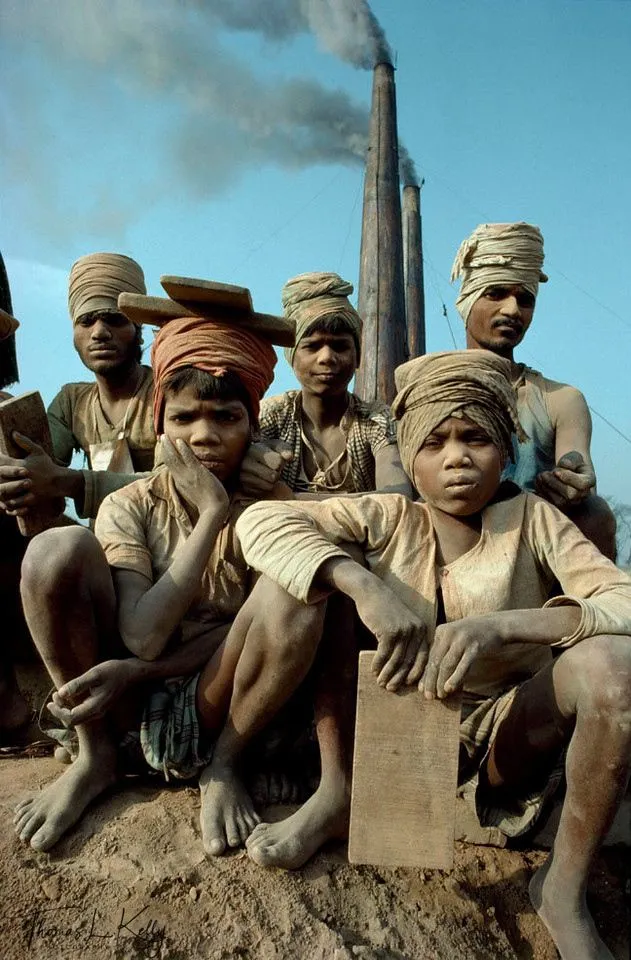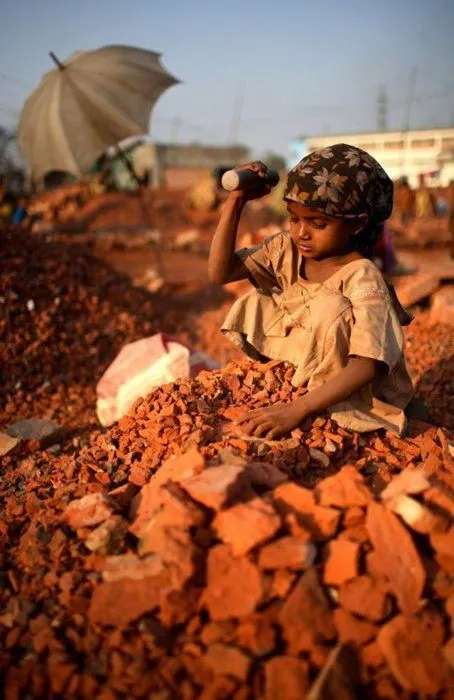Child labour is the labour provided by children in factories and
ofher realms of productionIt is equated with exploitanion, Working for long hours under phvsical and mentalconditions of sress and strain. The environments under which children work in factories are, to Say the least, favourable. Child labour is branded by various names, like bonded labour, forced labour etc. It is relevant to discuss, first of all, the causes of child labour in the Third World Countries in general and Pakistan in particular.
Economic poverty is cited to be the cause of child labour. Poor
parents are compelled to send their children, in urban areas to carpet manuiacturing sector in Pakistan where they work under extremely unfavourable environs. The term bonded labour applies to the children working tin different industries, either receiving no money or paltry amount for supplying. labour. The poor parents pledge their children to the factory owneřs, knowing little that they work under most dehumanising conditions. Likewise, children join motor workshops to become motor mechanics and the process of apprenticeship continues for a fairly long time, till depending upon their individual inclination to pick up the dynamics of motor/scooter
mechanics, are finally able to start their careers as mechanics
independently. During the period of training spreading over a number of decades, they have to remain content with whatever paltry wages they get, In the rural areas, children of primary school age are needed to work on family farms. Child labour is thus the result of economic
poverty.
It is interesting to discuss the rationale of this phenomenon
Michael P. Todaro in his book Economic Development in the Thira
World' (third edition) explains this most succinctly in the following words:
"First the private costs of primary education (especially in view
of the 'opportunity cost' of a child's labour to poor families) are higner
for poor Students than for more afiluent students. Second the expected benefits of primary education are lower for poor students. Together the higher costs and lower expected benefits of education mean that a poor family's "rate of return from investment in a child's education is lower than it is for other families. The poor are, therefore, more likely
to drop out during early years of schooling... As a result of these higher opportunity costs, School attendance and therefore, school performance tends to be much lower for children of poor families than for those from relatively higher income backgrounds." Michal P. Todaro's views can help us understand the child labour's phenomenon. Economic poverty compels the rural parents to withdraw their children from primary schools to keep them engaged in some farming
operations owing to the opportunity cost of their children labour to them.
Likewise in urban areas, economic considerations motivate the
poor parents to push ther small children to factories to sell labour with no or any near wage. Economically speaking, it is poverty, squalor and hunger that contribute to child labour with its attendant excesses.
While child labour cannot be viewed with equanimity of mind
owing to various excesses attached to it, it has however, some
redeeming features. The children get on-the-job training in various technical vocations, and most of them turn out to be good mechanics to earn a good living in time to come. Through experience they learn the technicalities of their profession. However, if they were to receive the fundamental theoretical knowledge through preliminary training, their performance could immensly improve. The lack of theoretical
knowledge is a limiting factor to their efficiency. If this deficiency were overcome, it would go a long way to improve the labour productivity. It calls for making certain arrange ments of training for the exposure of labour to basic principles of mechanics.
The developed countries charge Pakistan for violating human
Tights of the child labour. The Western mass media criticises Pakistan for ignoring the rights of children by making them work, especially in carpet factories under inhuman conditions. Even sports goods, surgical instrument industries are also the target of employing the child labour. Organised sort of propaganda has been started against Pakistan, on the basis of which carpet-sports goods exports are refused enter into many developed countries. Child labour thus constitues a threat to pak exports, especially in carpet, sports, Surgical instruments sectors. It may be pointed out that child labour is employed even in the United States of America, india, Bangladesh,
Brazil and Mexco in varying degrees. The evil exists in many of the developed countries, where it is practised in the underdeveloped countries on a Comparatively large scale for reasons not above. From amongst the human rights, the first right is to live it is a right ot subsistence. Other rights come later. The US has not guaranteed the subsistence rights to its citizens. Subsistence rights are, how ever, guaranteed in the UK. The US is a violator of the subsistence right, and as Such it needs to be tried on this score. The developed nations, if at all they are to insist for the protection of human rights, should force the govermments in underdeveloped countries to guarantee subsistence to all the citizems.
The economically developed countries also should enforce subsistence rights in their own land. The developed countries don't bother about this right to be enforced in the poor countries as they are not interested in the survival of the poor. Above all, they themselves follow such econmic policies at the international plane as to keep the poor in a state oi permanent poverty. They talk glibly of poverty in a rhetorical manner but are not much interested in its eradication. They indirectly wish the perpetration of poverty as its continuation indirectly contributes to their prosperity. The developed countries
instead of finding fault with the child labour on grounds of human rights violation, should endeavour to ensure the observance of the first right to live. If this right were met many of the evils of child labour would vanish. It is economic poverty which leads to the emergence of child labour, followed by excesses in the form of the violation of rights of children.
I deem it proper to point out here that in the beginning of the
Seventeenth Century, some Europeans left for the North America, where they butchered the Red Indians to establish the US. According to Dr. A.H. Khayal, the White House is founded upon the innumerable skulls of the Red Indians. The very foundation of the US rests on aggression, and it looks somewhat odd when the US talks about non aggression or preaches for the restoration of human rights relating
child labour. The US committed aggression against the Norun
Vietnamese, who fought it most valiantly. The US demonstrated naked aggression resulting in tremendous loss of human life.
Similarly, all the presently developed powers having rootS
aggression, quote scriptures like a devil, when they propagate moral principles. They allege to keep aloft the torch of human rights when they themselves are the worst stream rollers of the same. It is political debauchery to talk about human rights by the developed countries, as are the practitioners expediency. When they wish to corner a popr country like Pakistan, they create a ring of human rights violation around it. It is a sort of political mode of achieving some mundane objective by pressurising a poor country and putting it to awkward position either through imposition of economic sanctions or rejection of its exports. This however, does not mean that Pakistan should not pay attention to deal with the evil of child labour. Arrangements must be made for imparting relevant education and the training of child labour. The government through legislation can effectively control the menace of child labour. It should be made incumbent on the manufacturers to arrange tor the technical training of labour. It can be facilitated through the estabiishment of labour training institutes at different places depending on the nature of localised industries. In Sialkot, the institute can provide theoretical-cum-practical training to labour in sports surgical instruments manuiacture. In Faisalabad,
arrangements can be made for the exposure of labour to the basic manufacturing processes in textile sector, This would go a long way to improve the productivity of labour.The need of the hour is to evolve a comprehensive integrated strategy, which should inter alia include the universalisation of primaryeducation, literacy formal, non-formal employment generating policy, sponsoring of technical institutes for
the training of labour.

[Image source] (https://pin.it/3sWYwxS)

